The Organisational Consequences of Work-Life Balance: An Essay
VerifiedAdded on 2021/04/05
|8
|2993
|341
Essay
AI Summary
This essay, authored by Nisha Patel, explores the significant organisational consequences of work-life balance. It highlights the challenges individuals face in balancing career and personal life, impacting job satisfaction and productivity. The essay discusses the importance of HRM in fostering work-life balance through flexible policies, training, and a supportive work environment. It examines the positive and negative consequences of work-life balance, including reduced stress, improved health, and increased job satisfaction, as well as stress, health issues, and financial problems. The essay also contrasts eastern and western perspectives on work-life balance, considering gender roles, societal expectations, and support systems, emphasizing the need for organisations to recognise and address the importance of employee well-being. The essay concludes by discussing the importance of HRM in maintaining a healthy work-life balance.
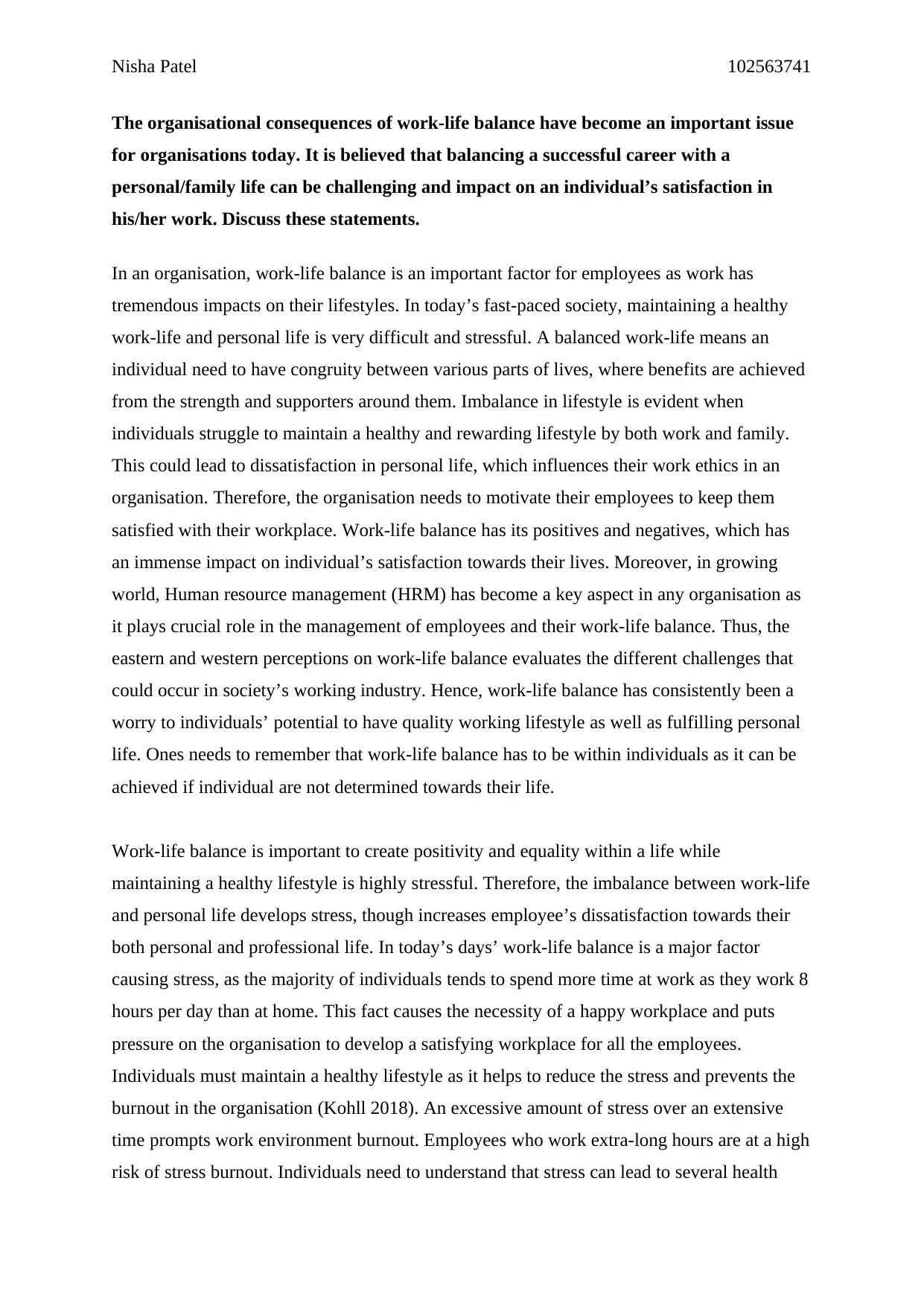
Nisha Patel 102563741
The organisational consequences of work-life balance have become an important issue
for organisations today. It is believed that balancing a successful career with a
personal/family life can be challenging and impact on an individual’s satisfaction in
his/her work. Discuss these statements.
In an organisation, work-life balance is an important factor for employees as work has
tremendous impacts on their lifestyles. In today’s fast-paced society, maintaining a healthy
work-life and personal life is very difficult and stressful. A balanced work-life means an
individual need to have congruity between various parts of lives, where benefits are achieved
from the strength and supporters around them. Imbalance in lifestyle is evident when
individuals struggle to maintain a healthy and rewarding lifestyle by both work and family.
This could lead to dissatisfaction in personal life, which influences their work ethics in an
organisation. Therefore, the organisation needs to motivate their employees to keep them
satisfied with their workplace. Work-life balance has its positives and negatives, which has
an immense impact on individual’s satisfaction towards their lives. Moreover, in growing
world, Human resource management (HRM) has become a key aspect in any organisation as
it plays crucial role in the management of employees and their work-life balance. Thus, the
eastern and western perceptions on work-life balance evaluates the different challenges that
could occur in society’s working industry. Hence, work-life balance has consistently been a
worry to individuals’ potential to have quality working lifestyle as well as fulfilling personal
life. Ones needs to remember that work-life balance has to be within individuals as it can be
achieved if individual are not determined towards their life.
Work-life balance is important to create positivity and equality within a life while
maintaining a healthy lifestyle is highly stressful. Therefore, the imbalance between work-life
and personal life develops stress, though increases employee’s dissatisfaction towards their
both personal and professional life. In today’s days’ work-life balance is a major factor
causing stress, as the majority of individuals tends to spend more time at work as they work 8
hours per day than at home. This fact causes the necessity of a happy workplace and puts
pressure on the organisation to develop a satisfying workplace for all the employees.
Individuals must maintain a healthy lifestyle as it helps to reduce the stress and prevents the
burnout in the organisation (Kohll 2018). An excessive amount of stress over an extensive
time prompts work environment burnout. Employees who work extra-long hours are at a high
risk of stress burnout. Individuals need to understand that stress can lead to several health
The organisational consequences of work-life balance have become an important issue
for organisations today. It is believed that balancing a successful career with a
personal/family life can be challenging and impact on an individual’s satisfaction in
his/her work. Discuss these statements.
In an organisation, work-life balance is an important factor for employees as work has
tremendous impacts on their lifestyles. In today’s fast-paced society, maintaining a healthy
work-life and personal life is very difficult and stressful. A balanced work-life means an
individual need to have congruity between various parts of lives, where benefits are achieved
from the strength and supporters around them. Imbalance in lifestyle is evident when
individuals struggle to maintain a healthy and rewarding lifestyle by both work and family.
This could lead to dissatisfaction in personal life, which influences their work ethics in an
organisation. Therefore, the organisation needs to motivate their employees to keep them
satisfied with their workplace. Work-life balance has its positives and negatives, which has
an immense impact on individual’s satisfaction towards their lives. Moreover, in growing
world, Human resource management (HRM) has become a key aspect in any organisation as
it plays crucial role in the management of employees and their work-life balance. Thus, the
eastern and western perceptions on work-life balance evaluates the different challenges that
could occur in society’s working industry. Hence, work-life balance has consistently been a
worry to individuals’ potential to have quality working lifestyle as well as fulfilling personal
life. Ones needs to remember that work-life balance has to be within individuals as it can be
achieved if individual are not determined towards their life.
Work-life balance is important to create positivity and equality within a life while
maintaining a healthy lifestyle is highly stressful. Therefore, the imbalance between work-life
and personal life develops stress, though increases employee’s dissatisfaction towards their
both personal and professional life. In today’s days’ work-life balance is a major factor
causing stress, as the majority of individuals tends to spend more time at work as they work 8
hours per day than at home. This fact causes the necessity of a happy workplace and puts
pressure on the organisation to develop a satisfying workplace for all the employees.
Individuals must maintain a healthy lifestyle as it helps to reduce the stress and prevents the
burnout in the organisation (Kohll 2018). An excessive amount of stress over an extensive
time prompts work environment burnout. Employees who work extra-long hours are at a high
risk of stress burnout. Individuals need to understand that stress can lead to several health
Paraphrase This Document
Need a fresh take? Get an instant paraphrase of this document with our AI Paraphraser
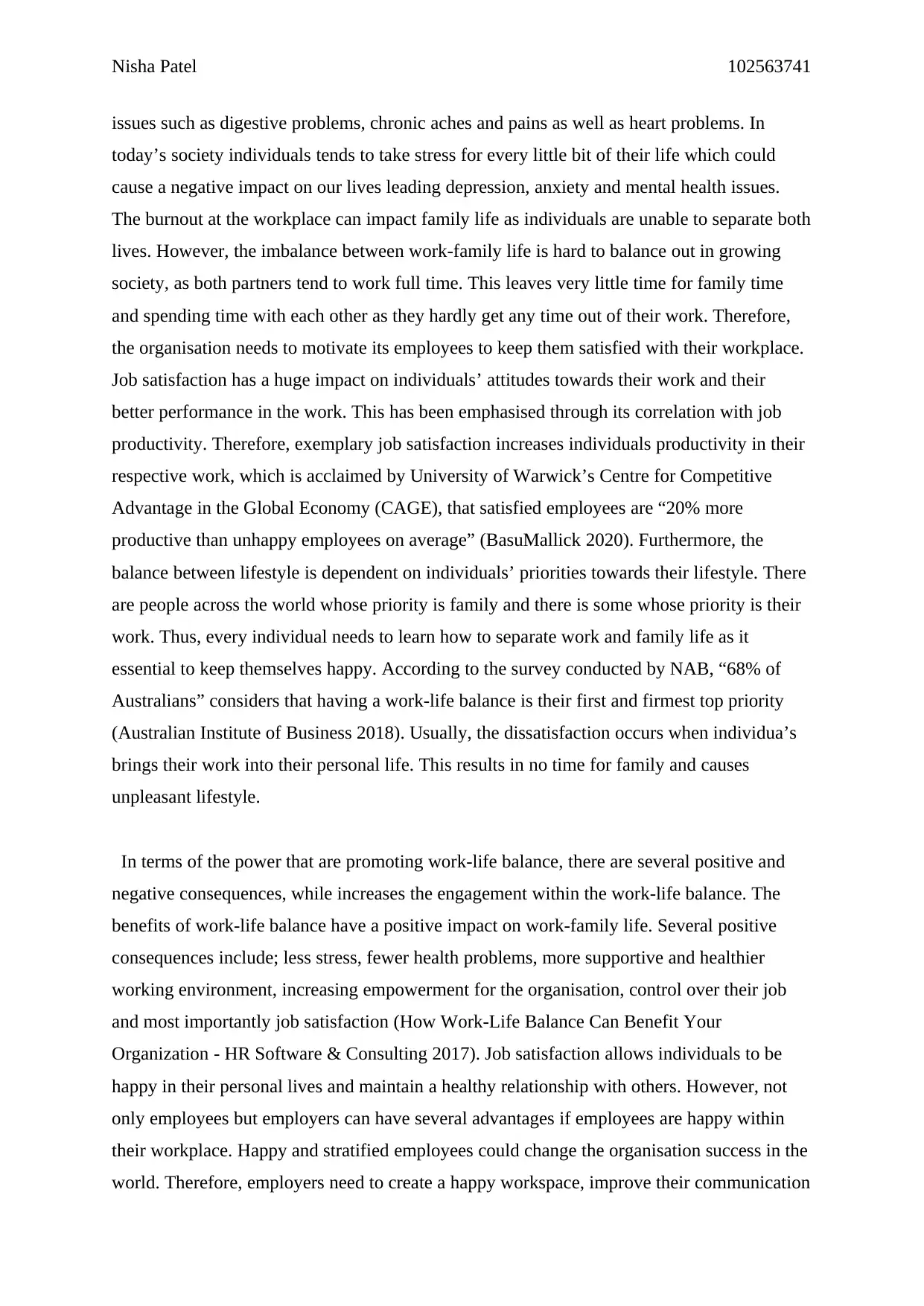
Nisha Patel 102563741
issues such as digestive problems, chronic aches and pains as well as heart problems. In
today’s society individuals tends to take stress for every little bit of their life which could
cause a negative impact on our lives leading depression, anxiety and mental health issues.
The burnout at the workplace can impact family life as individuals are unable to separate both
lives. However, the imbalance between work-family life is hard to balance out in growing
society, as both partners tend to work full time. This leaves very little time for family time
and spending time with each other as they hardly get any time out of their work. Therefore,
the organisation needs to motivate its employees to keep them satisfied with their workplace.
Job satisfaction has a huge impact on individuals’ attitudes towards their work and their
better performance in the work. This has been emphasised through its correlation with job
productivity. Therefore, exemplary job satisfaction increases individuals productivity in their
respective work, which is acclaimed by University of Warwick’s Centre for Competitive
Advantage in the Global Economy (CAGE), that satisfied employees are “20% more
productive than unhappy employees on average” (BasuMallick 2020). Furthermore, the
balance between lifestyle is dependent on individuals’ priorities towards their lifestyle. There
are people across the world whose priority is family and there is some whose priority is their
work. Thus, every individual needs to learn how to separate work and family life as it
essential to keep themselves happy. According to the survey conducted by NAB, “68% of
Australians” considers that having a work-life balance is their first and firmest top priority
(Australian Institute of Business 2018). Usually, the dissatisfaction occurs when individua’s
brings their work into their personal life. This results in no time for family and causes
unpleasant lifestyle.
In terms of the power that are promoting work-life balance, there are several positive and
negative consequences, while increases the engagement within the work-life balance. The
benefits of work-life balance have a positive impact on work-family life. Several positive
consequences include; less stress, fewer health problems, more supportive and healthier
working environment, increasing empowerment for the organisation, control over their job
and most importantly job satisfaction (How Work-Life Balance Can Benefit Your
Organization - HR Software & Consulting 2017). Job satisfaction allows individuals to be
happy in their personal lives and maintain a healthy relationship with others. However, not
only employees but employers can have several advantages if employees are happy within
their workplace. Happy and stratified employees could change the organisation success in the
world. Therefore, employers need to create a happy workspace, improve their communication
issues such as digestive problems, chronic aches and pains as well as heart problems. In
today’s society individuals tends to take stress for every little bit of their life which could
cause a negative impact on our lives leading depression, anxiety and mental health issues.
The burnout at the workplace can impact family life as individuals are unable to separate both
lives. However, the imbalance between work-family life is hard to balance out in growing
society, as both partners tend to work full time. This leaves very little time for family time
and spending time with each other as they hardly get any time out of their work. Therefore,
the organisation needs to motivate its employees to keep them satisfied with their workplace.
Job satisfaction has a huge impact on individuals’ attitudes towards their work and their
better performance in the work. This has been emphasised through its correlation with job
productivity. Therefore, exemplary job satisfaction increases individuals productivity in their
respective work, which is acclaimed by University of Warwick’s Centre for Competitive
Advantage in the Global Economy (CAGE), that satisfied employees are “20% more
productive than unhappy employees on average” (BasuMallick 2020). Furthermore, the
balance between lifestyle is dependent on individuals’ priorities towards their lifestyle. There
are people across the world whose priority is family and there is some whose priority is their
work. Thus, every individual needs to learn how to separate work and family life as it
essential to keep themselves happy. According to the survey conducted by NAB, “68% of
Australians” considers that having a work-life balance is their first and firmest top priority
(Australian Institute of Business 2018). Usually, the dissatisfaction occurs when individua’s
brings their work into their personal life. This results in no time for family and causes
unpleasant lifestyle.
In terms of the power that are promoting work-life balance, there are several positive and
negative consequences, while increases the engagement within the work-life balance. The
benefits of work-life balance have a positive impact on work-family life. Several positive
consequences include; less stress, fewer health problems, more supportive and healthier
working environment, increasing empowerment for the organisation, control over their job
and most importantly job satisfaction (How Work-Life Balance Can Benefit Your
Organization - HR Software & Consulting 2017). Job satisfaction allows individuals to be
happy in their personal lives and maintain a healthy relationship with others. However, not
only employees but employers can have several advantages if employees are happy within
their workplace. Happy and stratified employees could change the organisation success in the
world. Therefore, employers need to create a happy workspace, improve their communication
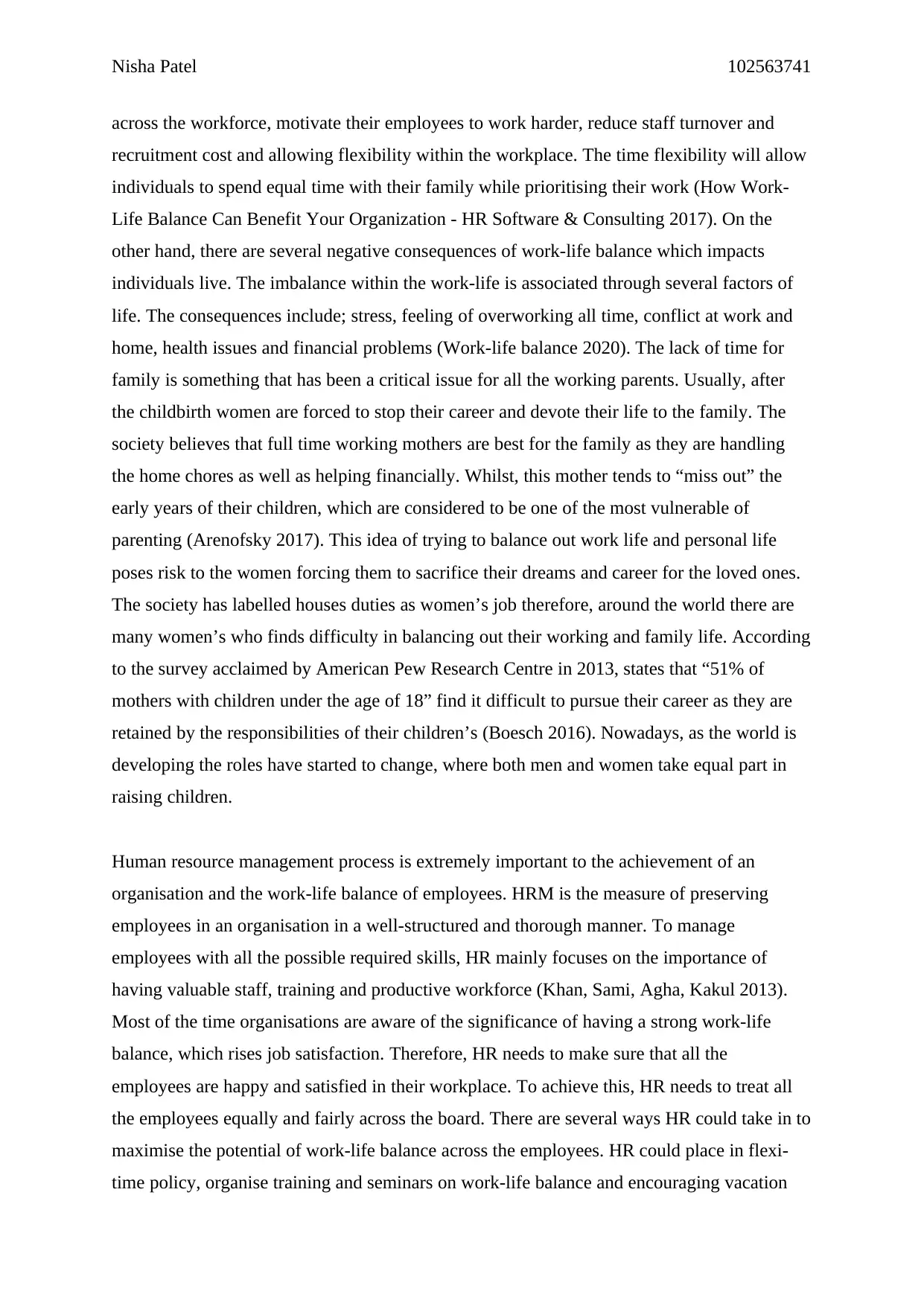
Nisha Patel 102563741
across the workforce, motivate their employees to work harder, reduce staff turnover and
recruitment cost and allowing flexibility within the workplace. The time flexibility will allow
individuals to spend equal time with their family while prioritising their work (How Work-
Life Balance Can Benefit Your Organization - HR Software & Consulting 2017). On the
other hand, there are several negative consequences of work-life balance which impacts
individuals live. The imbalance within the work-life is associated through several factors of
life. The consequences include; stress, feeling of overworking all time, conflict at work and
home, health issues and financial problems (Work-life balance 2020). The lack of time for
family is something that has been a critical issue for all the working parents. Usually, after
the childbirth women are forced to stop their career and devote their life to the family. The
society believes that full time working mothers are best for the family as they are handling
the home chores as well as helping financially. Whilst, this mother tends to “miss out” the
early years of their children, which are considered to be one of the most vulnerable of
parenting (Arenofsky 2017). This idea of trying to balance out work life and personal life
poses risk to the women forcing them to sacrifice their dreams and career for the loved ones.
The society has labelled houses duties as women’s job therefore, around the world there are
many women’s who finds difficulty in balancing out their working and family life. According
to the survey acclaimed by American Pew Research Centre in 2013, states that “51% of
mothers with children under the age of 18” find it difficult to pursue their career as they are
retained by the responsibilities of their children’s (Boesch 2016). Nowadays, as the world is
developing the roles have started to change, where both men and women take equal part in
raising children.
Human resource management process is extremely important to the achievement of an
organisation and the work-life balance of employees. HRM is the measure of preserving
employees in an organisation in a well-structured and thorough manner. To manage
employees with all the possible required skills, HR mainly focuses on the importance of
having valuable staff, training and productive workforce (Khan, Sami, Agha, Kakul 2013).
Most of the time organisations are aware of the significance of having a strong work-life
balance, which rises job satisfaction. Therefore, HR needs to make sure that all the
employees are happy and satisfied in their workplace. To achieve this, HR needs to treat all
the employees equally and fairly across the board. There are several ways HR could take in to
maximise the potential of work-life balance across the employees. HR could place in flexi-
time policy, organise training and seminars on work-life balance and encouraging vacation
across the workforce, motivate their employees to work harder, reduce staff turnover and
recruitment cost and allowing flexibility within the workplace. The time flexibility will allow
individuals to spend equal time with their family while prioritising their work (How Work-
Life Balance Can Benefit Your Organization - HR Software & Consulting 2017). On the
other hand, there are several negative consequences of work-life balance which impacts
individuals live. The imbalance within the work-life is associated through several factors of
life. The consequences include; stress, feeling of overworking all time, conflict at work and
home, health issues and financial problems (Work-life balance 2020). The lack of time for
family is something that has been a critical issue for all the working parents. Usually, after
the childbirth women are forced to stop their career and devote their life to the family. The
society believes that full time working mothers are best for the family as they are handling
the home chores as well as helping financially. Whilst, this mother tends to “miss out” the
early years of their children, which are considered to be one of the most vulnerable of
parenting (Arenofsky 2017). This idea of trying to balance out work life and personal life
poses risk to the women forcing them to sacrifice their dreams and career for the loved ones.
The society has labelled houses duties as women’s job therefore, around the world there are
many women’s who finds difficulty in balancing out their working and family life. According
to the survey acclaimed by American Pew Research Centre in 2013, states that “51% of
mothers with children under the age of 18” find it difficult to pursue their career as they are
retained by the responsibilities of their children’s (Boesch 2016). Nowadays, as the world is
developing the roles have started to change, where both men and women take equal part in
raising children.
Human resource management process is extremely important to the achievement of an
organisation and the work-life balance of employees. HRM is the measure of preserving
employees in an organisation in a well-structured and thorough manner. To manage
employees with all the possible required skills, HR mainly focuses on the importance of
having valuable staff, training and productive workforce (Khan, Sami, Agha, Kakul 2013).
Most of the time organisations are aware of the significance of having a strong work-life
balance, which rises job satisfaction. Therefore, HR needs to make sure that all the
employees are happy and satisfied in their workplace. To achieve this, HR needs to treat all
the employees equally and fairly across the board. There are several ways HR could take in to
maximise the potential of work-life balance across the employees. HR could place in flexi-
time policy, organise training and seminars on work-life balance and encouraging vacation
⊘ This is a preview!⊘
Do you want full access?
Subscribe today to unlock all pages.

Trusted by 1+ million students worldwide
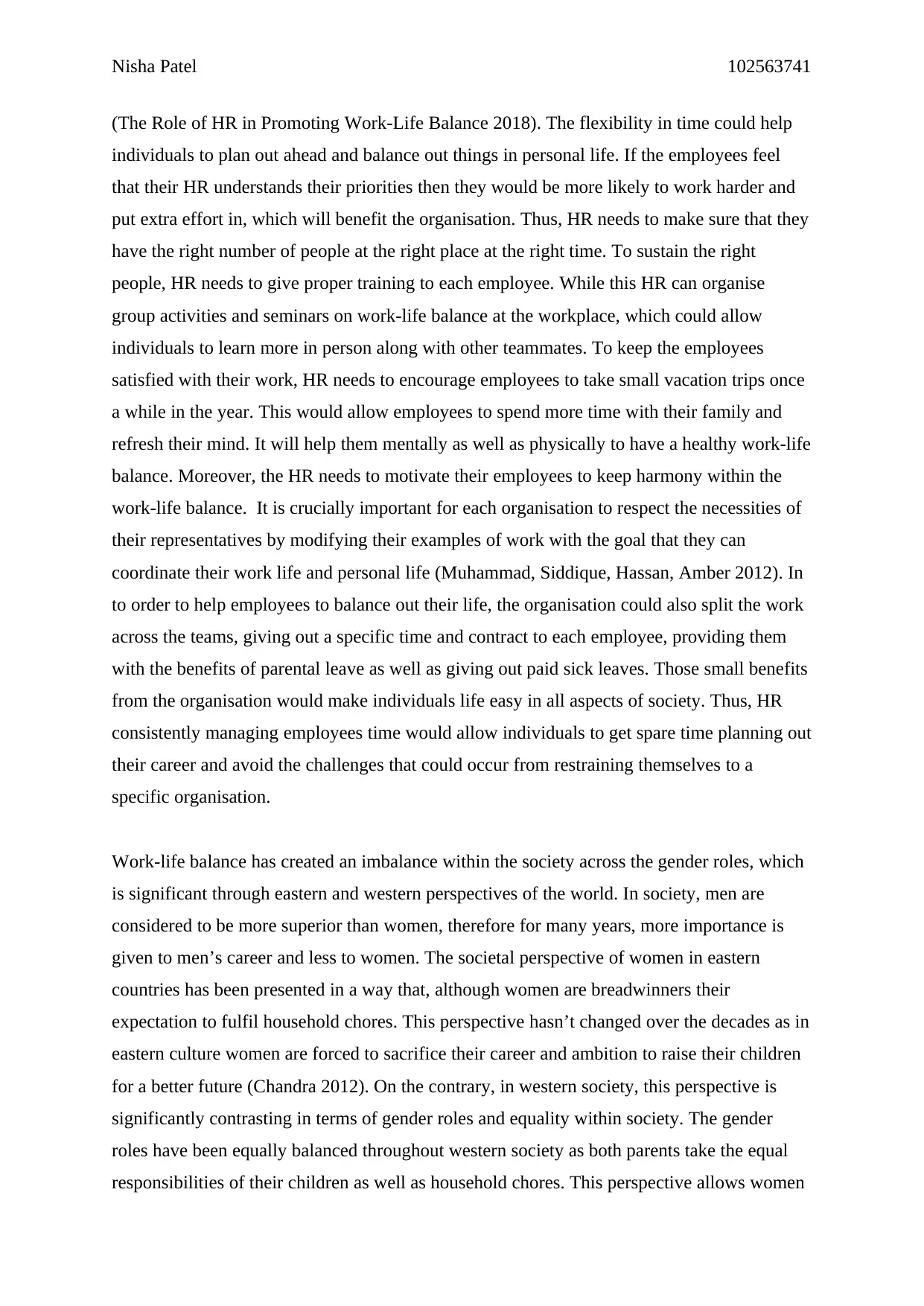
Nisha Patel 102563741
(The Role of HR in Promoting Work-Life Balance 2018). The flexibility in time could help
individuals to plan out ahead and balance out things in personal life. If the employees feel
that their HR understands their priorities then they would be more likely to work harder and
put extra effort in, which will benefit the organisation. Thus, HR needs to make sure that they
have the right number of people at the right place at the right time. To sustain the right
people, HR needs to give proper training to each employee. While this HR can organise
group activities and seminars on work-life balance at the workplace, which could allow
individuals to learn more in person along with other teammates. To keep the employees
satisfied with their work, HR needs to encourage employees to take small vacation trips once
a while in the year. This would allow employees to spend more time with their family and
refresh their mind. It will help them mentally as well as physically to have a healthy work-life
balance. Moreover, the HR needs to motivate their employees to keep harmony within the
work-life balance. It is crucially important for each organisation to respect the necessities of
their representatives by modifying their examples of work with the goal that they can
coordinate their work life and personal life (Muhammad, Siddique, Hassan, Amber 2012). In
to order to help employees to balance out their life, the organisation could also split the work
across the teams, giving out a specific time and contract to each employee, providing them
with the benefits of parental leave as well as giving out paid sick leaves. Those small benefits
from the organisation would make individuals life easy in all aspects of society. Thus, HR
consistently managing employees time would allow individuals to get spare time planning out
their career and avoid the challenges that could occur from restraining themselves to a
specific organisation.
Work-life balance has created an imbalance within the society across the gender roles, which
is significant through eastern and western perspectives of the world. In society, men are
considered to be more superior than women, therefore for many years, more importance is
given to men’s career and less to women. The societal perspective of women in eastern
countries has been presented in a way that, although women are breadwinners their
expectation to fulfil household chores. This perspective hasn’t changed over the decades as in
eastern culture women are forced to sacrifice their career and ambition to raise their children
for a better future (Chandra 2012). On the contrary, in western society, this perspective is
significantly contrasting in terms of gender roles and equality within society. The gender
roles have been equally balanced throughout western society as both parents take the equal
responsibilities of their children as well as household chores. This perspective allows women
(The Role of HR in Promoting Work-Life Balance 2018). The flexibility in time could help
individuals to plan out ahead and balance out things in personal life. If the employees feel
that their HR understands their priorities then they would be more likely to work harder and
put extra effort in, which will benefit the organisation. Thus, HR needs to make sure that they
have the right number of people at the right place at the right time. To sustain the right
people, HR needs to give proper training to each employee. While this HR can organise
group activities and seminars on work-life balance at the workplace, which could allow
individuals to learn more in person along with other teammates. To keep the employees
satisfied with their work, HR needs to encourage employees to take small vacation trips once
a while in the year. This would allow employees to spend more time with their family and
refresh their mind. It will help them mentally as well as physically to have a healthy work-life
balance. Moreover, the HR needs to motivate their employees to keep harmony within the
work-life balance. It is crucially important for each organisation to respect the necessities of
their representatives by modifying their examples of work with the goal that they can
coordinate their work life and personal life (Muhammad, Siddique, Hassan, Amber 2012). In
to order to help employees to balance out their life, the organisation could also split the work
across the teams, giving out a specific time and contract to each employee, providing them
with the benefits of parental leave as well as giving out paid sick leaves. Those small benefits
from the organisation would make individuals life easy in all aspects of society. Thus, HR
consistently managing employees time would allow individuals to get spare time planning out
their career and avoid the challenges that could occur from restraining themselves to a
specific organisation.
Work-life balance has created an imbalance within the society across the gender roles, which
is significant through eastern and western perspectives of the world. In society, men are
considered to be more superior than women, therefore for many years, more importance is
given to men’s career and less to women. The societal perspective of women in eastern
countries has been presented in a way that, although women are breadwinners their
expectation to fulfil household chores. This perspective hasn’t changed over the decades as in
eastern culture women are forced to sacrifice their career and ambition to raise their children
for a better future (Chandra 2012). On the contrary, in western society, this perspective is
significantly contrasting in terms of gender roles and equality within society. The gender
roles have been equally balanced throughout western society as both parents take the equal
responsibilities of their children as well as household chores. This perspective allows women
Paraphrase This Document
Need a fresh take? Get an instant paraphrase of this document with our AI Paraphraser
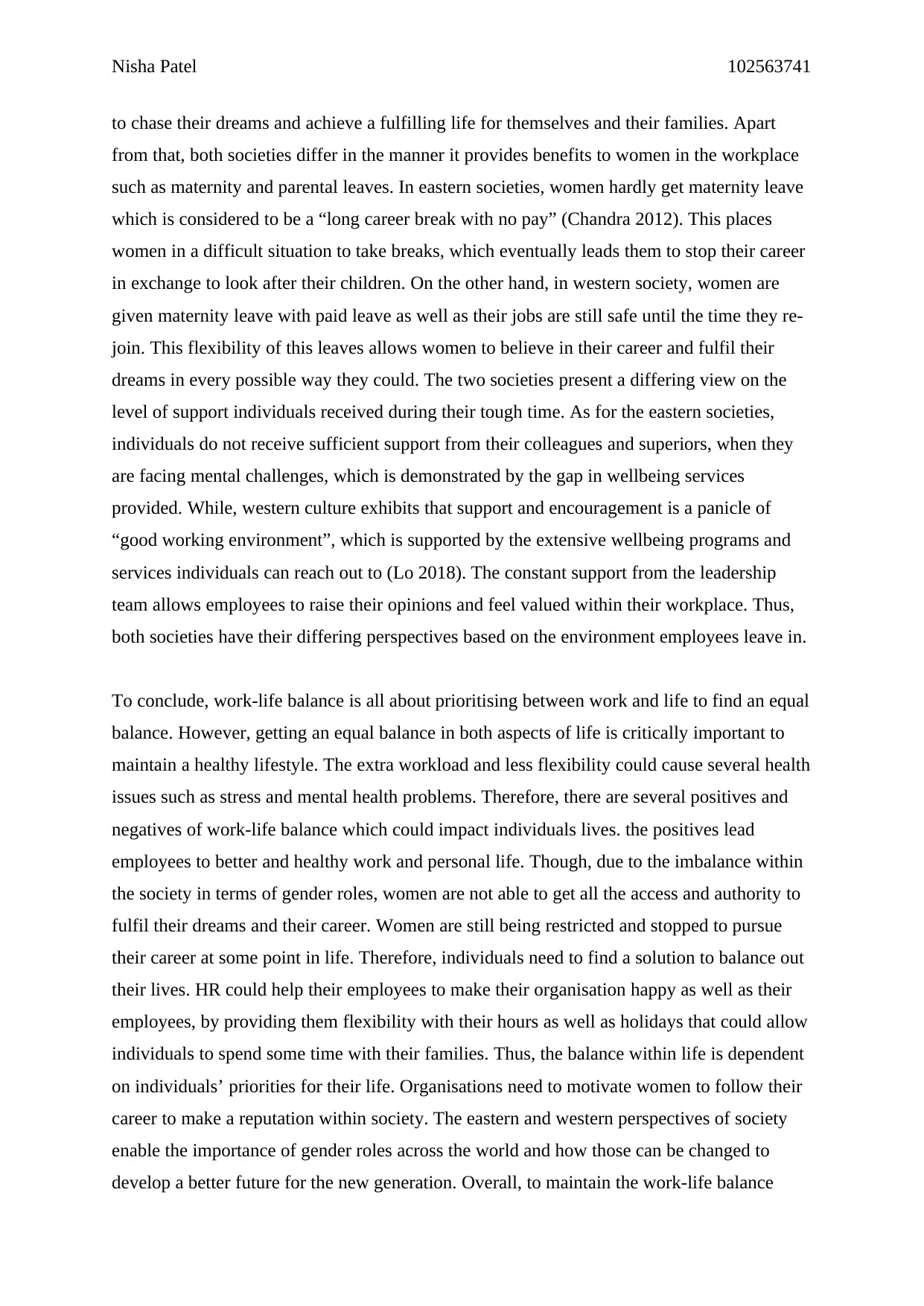
Nisha Patel 102563741
to chase their dreams and achieve a fulfilling life for themselves and their families. Apart
from that, both societies differ in the manner it provides benefits to women in the workplace
such as maternity and parental leaves. In eastern societies, women hardly get maternity leave
which is considered to be a “long career break with no pay” (Chandra 2012). This places
women in a difficult situation to take breaks, which eventually leads them to stop their career
in exchange to look after their children. On the other hand, in western society, women are
given maternity leave with paid leave as well as their jobs are still safe until the time they re-
join. This flexibility of this leaves allows women to believe in their career and fulfil their
dreams in every possible way they could. The two societies present a differing view on the
level of support individuals received during their tough time. As for the eastern societies,
individuals do not receive sufficient support from their colleagues and superiors, when they
are facing mental challenges, which is demonstrated by the gap in wellbeing services
provided. While, western culture exhibits that support and encouragement is a panicle of
“good working environment”, which is supported by the extensive wellbeing programs and
services individuals can reach out to (Lo 2018). The constant support from the leadership
team allows employees to raise their opinions and feel valued within their workplace. Thus,
both societies have their differing perspectives based on the environment employees leave in.
To conclude, work-life balance is all about prioritising between work and life to find an equal
balance. However, getting an equal balance in both aspects of life is critically important to
maintain a healthy lifestyle. The extra workload and less flexibility could cause several health
issues such as stress and mental health problems. Therefore, there are several positives and
negatives of work-life balance which could impact individuals lives. the positives lead
employees to better and healthy work and personal life. Though, due to the imbalance within
the society in terms of gender roles, women are not able to get all the access and authority to
fulfil their dreams and their career. Women are still being restricted and stopped to pursue
their career at some point in life. Therefore, individuals need to find a solution to balance out
their lives. HR could help their employees to make their organisation happy as well as their
employees, by providing them flexibility with their hours as well as holidays that could allow
individuals to spend some time with their families. Thus, the balance within life is dependent
on individuals’ priorities for their life. Organisations need to motivate women to follow their
career to make a reputation within society. The eastern and western perspectives of society
enable the importance of gender roles across the world and how those can be changed to
develop a better future for the new generation. Overall, to maintain the work-life balance
to chase their dreams and achieve a fulfilling life for themselves and their families. Apart
from that, both societies differ in the manner it provides benefits to women in the workplace
such as maternity and parental leaves. In eastern societies, women hardly get maternity leave
which is considered to be a “long career break with no pay” (Chandra 2012). This places
women in a difficult situation to take breaks, which eventually leads them to stop their career
in exchange to look after their children. On the other hand, in western society, women are
given maternity leave with paid leave as well as their jobs are still safe until the time they re-
join. This flexibility of this leaves allows women to believe in their career and fulfil their
dreams in every possible way they could. The two societies present a differing view on the
level of support individuals received during their tough time. As for the eastern societies,
individuals do not receive sufficient support from their colleagues and superiors, when they
are facing mental challenges, which is demonstrated by the gap in wellbeing services
provided. While, western culture exhibits that support and encouragement is a panicle of
“good working environment”, which is supported by the extensive wellbeing programs and
services individuals can reach out to (Lo 2018). The constant support from the leadership
team allows employees to raise their opinions and feel valued within their workplace. Thus,
both societies have their differing perspectives based on the environment employees leave in.
To conclude, work-life balance is all about prioritising between work and life to find an equal
balance. However, getting an equal balance in both aspects of life is critically important to
maintain a healthy lifestyle. The extra workload and less flexibility could cause several health
issues such as stress and mental health problems. Therefore, there are several positives and
negatives of work-life balance which could impact individuals lives. the positives lead
employees to better and healthy work and personal life. Though, due to the imbalance within
the society in terms of gender roles, women are not able to get all the access and authority to
fulfil their dreams and their career. Women are still being restricted and stopped to pursue
their career at some point in life. Therefore, individuals need to find a solution to balance out
their lives. HR could help their employees to make their organisation happy as well as their
employees, by providing them flexibility with their hours as well as holidays that could allow
individuals to spend some time with their families. Thus, the balance within life is dependent
on individuals’ priorities for their life. Organisations need to motivate women to follow their
career to make a reputation within society. The eastern and western perspectives of society
enable the importance of gender roles across the world and how those can be changed to
develop a better future for the new generation. Overall, to maintain the work-life balance
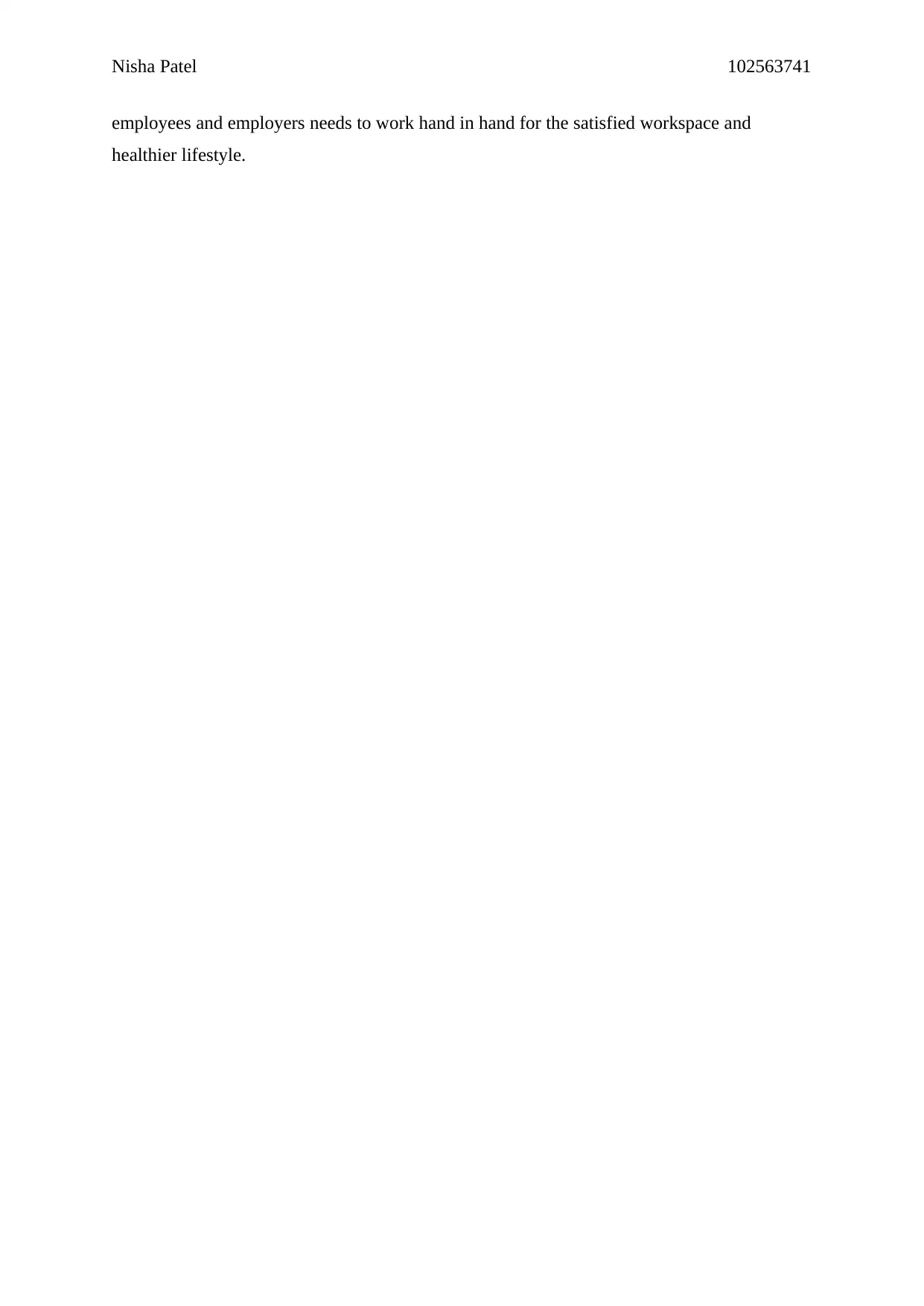
Nisha Patel 102563741
employees and employers needs to work hand in hand for the satisfied workspace and
healthier lifestyle.
employees and employers needs to work hand in hand for the satisfied workspace and
healthier lifestyle.
⊘ This is a preview!⊘
Do you want full access?
Subscribe today to unlock all pages.

Trusted by 1+ million students worldwide
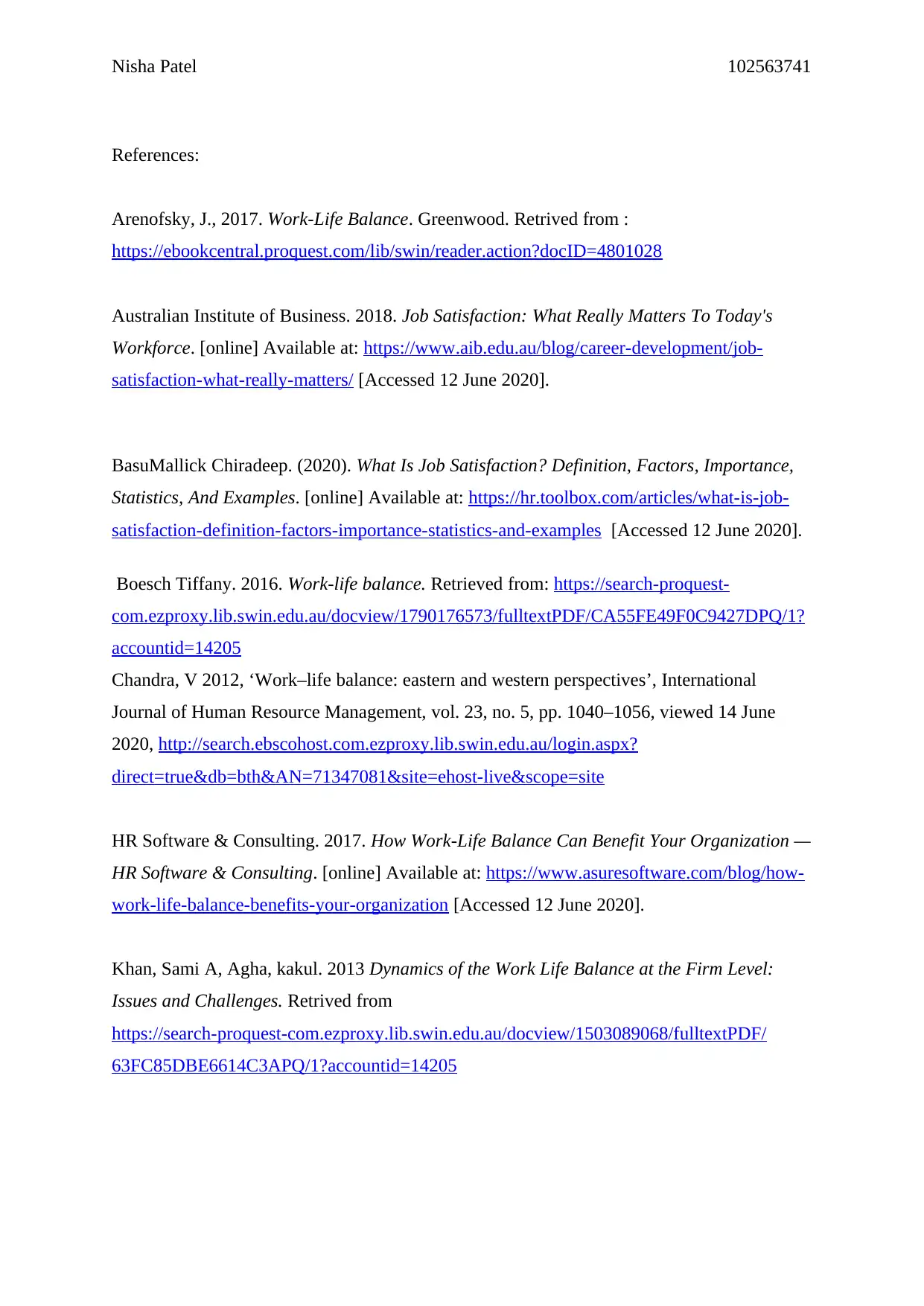
Nisha Patel 102563741
References:
Arenofsky, J., 2017. Work-Life Balance. Greenwood. Retrived from :
https://ebookcentral.proquest.com/lib/swin/reader.action?docID=4801028
Australian Institute of Business. 2018. Job Satisfaction: What Really Matters To Today's
Workforce. [online] Available at: https://www.aib.edu.au/blog/career-development/job-
satisfaction-what-really-matters/ [Accessed 12 June 2020].
BasuMallick Chiradeep. (2020). What Is Job Satisfaction? Definition, Factors, Importance,
Statistics, And Examples. [online] Available at: https://hr.toolbox.com/articles/what-is-job-
satisfaction-definition-factors-importance-statistics-and-examples [Accessed 12 June 2020].
Boesch Tiffany. 2016. Work-life balance. Retrieved from: https://search-proquest-
com.ezproxy.lib.swin.edu.au/docview/1790176573/fulltextPDF/CA55FE49F0C9427DPQ/1?
accountid=14205
Chandra, V 2012, ‘Work–life balance: eastern and western perspectives’, International
Journal of Human Resource Management, vol. 23, no. 5, pp. 1040–1056, viewed 14 June
2020, http://search.ebscohost.com.ezproxy.lib.swin.edu.au/login.aspx?
direct=true&db=bth&AN=71347081&site=ehost-live&scope=site
HR Software & Consulting. 2017. How Work-Life Balance Can Benefit Your Organization —
HR Software & Consulting. [online] Available at: https://www.asuresoftware.com/blog/how-
work-life-balance-benefits-your-organization [Accessed 12 June 2020].
Khan, Sami A, Agha, kakul. 2013 Dynamics of the Work Life Balance at the Firm Level:
Issues and Challenges. Retrived from
https://search-proquest-com.ezproxy.lib.swin.edu.au/docview/1503089068/fulltextPDF/
63FC85DBE6614C3APQ/1?accountid=14205
References:
Arenofsky, J., 2017. Work-Life Balance. Greenwood. Retrived from :
https://ebookcentral.proquest.com/lib/swin/reader.action?docID=4801028
Australian Institute of Business. 2018. Job Satisfaction: What Really Matters To Today's
Workforce. [online] Available at: https://www.aib.edu.au/blog/career-development/job-
satisfaction-what-really-matters/ [Accessed 12 June 2020].
BasuMallick Chiradeep. (2020). What Is Job Satisfaction? Definition, Factors, Importance,
Statistics, And Examples. [online] Available at: https://hr.toolbox.com/articles/what-is-job-
satisfaction-definition-factors-importance-statistics-and-examples [Accessed 12 June 2020].
Boesch Tiffany. 2016. Work-life balance. Retrieved from: https://search-proquest-
com.ezproxy.lib.swin.edu.au/docview/1790176573/fulltextPDF/CA55FE49F0C9427DPQ/1?
accountid=14205
Chandra, V 2012, ‘Work–life balance: eastern and western perspectives’, International
Journal of Human Resource Management, vol. 23, no. 5, pp. 1040–1056, viewed 14 June
2020, http://search.ebscohost.com.ezproxy.lib.swin.edu.au/login.aspx?
direct=true&db=bth&AN=71347081&site=ehost-live&scope=site
HR Software & Consulting. 2017. How Work-Life Balance Can Benefit Your Organization —
HR Software & Consulting. [online] Available at: https://www.asuresoftware.com/blog/how-
work-life-balance-benefits-your-organization [Accessed 12 June 2020].
Khan, Sami A, Agha, kakul. 2013 Dynamics of the Work Life Balance at the Firm Level:
Issues and Challenges. Retrived from
https://search-proquest-com.ezproxy.lib.swin.edu.au/docview/1503089068/fulltextPDF/
63FC85DBE6614C3APQ/1?accountid=14205
Paraphrase This Document
Need a fresh take? Get an instant paraphrase of this document with our AI Paraphraser
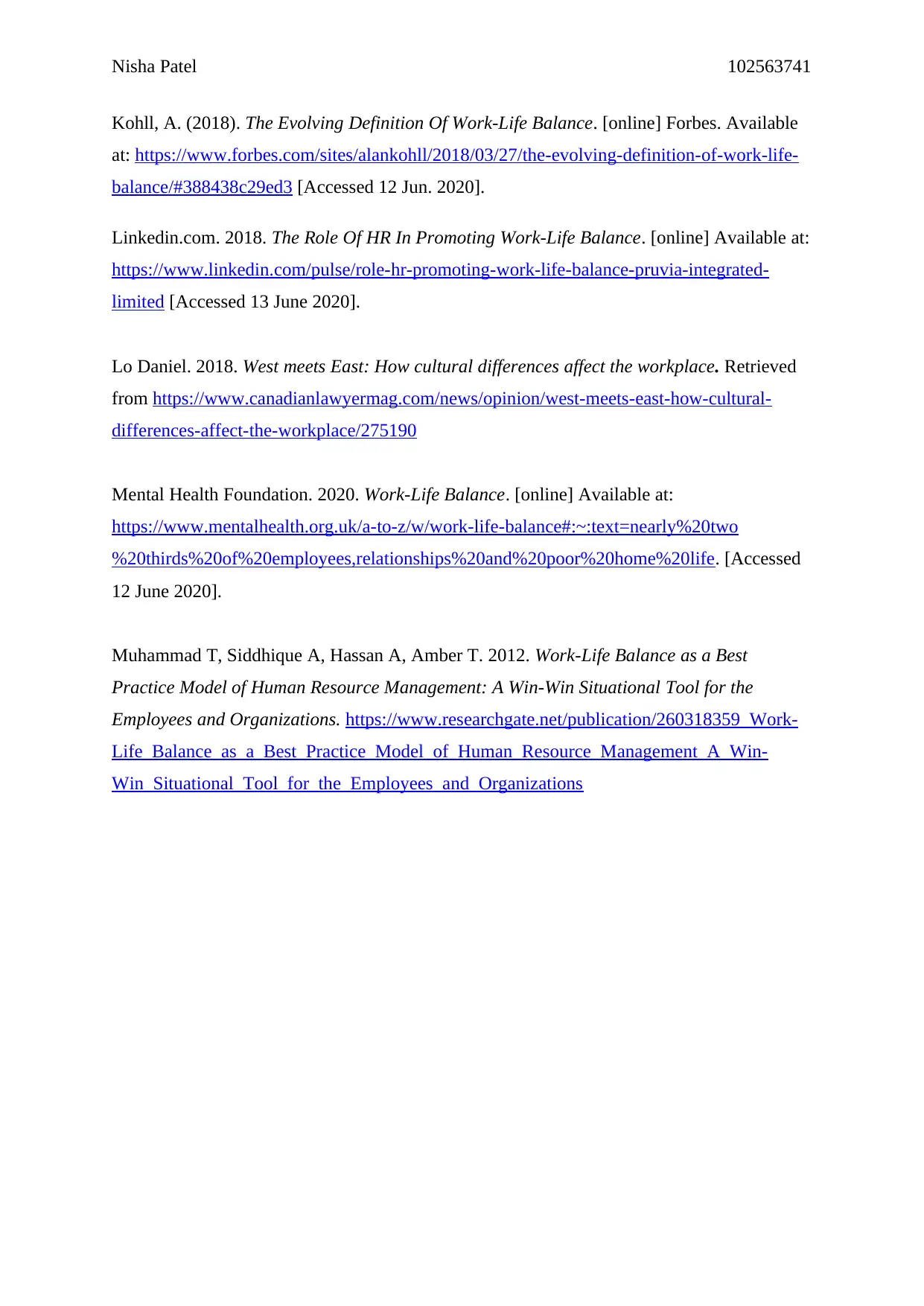
Nisha Patel 102563741
Kohll, A. (2018). The Evolving Definition Of Work-Life Balance. [online] Forbes. Available
at: https://www.forbes.com/sites/alankohll/2018/03/27/the-evolving-definition-of-work-life-
balance/#388438c29ed3 [Accessed 12 Jun. 2020].
Linkedin.com. 2018. The Role Of HR In Promoting Work-Life Balance. [online] Available at:
https://www.linkedin.com/pulse/role-hr-promoting-work-life-balance-pruvia-integrated-
limited [Accessed 13 June 2020].
Lo Daniel. 2018. West meets East: How cultural differences affect the workplace. Retrieved
from https://www.canadianlawyermag.com/news/opinion/west-meets-east-how-cultural-
differences-affect-the-workplace/275190
Mental Health Foundation. 2020. Work-Life Balance. [online] Available at:
https://www.mentalhealth.org.uk/a-to-z/w/work-life-balance#:~:text=nearly%20two
%20thirds%20of%20employees,relationships%20and%20poor%20home%20life. [Accessed
12 June 2020].
Muhammad T, Siddhique A, Hassan A, Amber T. 2012. Work-Life Balance as a Best
Practice Model of Human Resource Management: A Win-Win Situational Tool for the
Employees and Organizations. https://www.researchgate.net/publication/260318359_Work-
Life_Balance_as_a_Best_Practice_Model_of_Human_Resource_Management_A_Win-
Win_Situational_Tool_for_the_Employees_and_Organizations
Kohll, A. (2018). The Evolving Definition Of Work-Life Balance. [online] Forbes. Available
at: https://www.forbes.com/sites/alankohll/2018/03/27/the-evolving-definition-of-work-life-
balance/#388438c29ed3 [Accessed 12 Jun. 2020].
Linkedin.com. 2018. The Role Of HR In Promoting Work-Life Balance. [online] Available at:
https://www.linkedin.com/pulse/role-hr-promoting-work-life-balance-pruvia-integrated-
limited [Accessed 13 June 2020].
Lo Daniel. 2018. West meets East: How cultural differences affect the workplace. Retrieved
from https://www.canadianlawyermag.com/news/opinion/west-meets-east-how-cultural-
differences-affect-the-workplace/275190
Mental Health Foundation. 2020. Work-Life Balance. [online] Available at:
https://www.mentalhealth.org.uk/a-to-z/w/work-life-balance#:~:text=nearly%20two
%20thirds%20of%20employees,relationships%20and%20poor%20home%20life. [Accessed
12 June 2020].
Muhammad T, Siddhique A, Hassan A, Amber T. 2012. Work-Life Balance as a Best
Practice Model of Human Resource Management: A Win-Win Situational Tool for the
Employees and Organizations. https://www.researchgate.net/publication/260318359_Work-
Life_Balance_as_a_Best_Practice_Model_of_Human_Resource_Management_A_Win-
Win_Situational_Tool_for_the_Employees_and_Organizations
1 out of 8
Related Documents
Your All-in-One AI-Powered Toolkit for Academic Success.
+13062052269
info@desklib.com
Available 24*7 on WhatsApp / Email
![[object Object]](/_next/static/media/star-bottom.7253800d.svg)
Unlock your academic potential
Copyright © 2020–2025 A2Z Services. All Rights Reserved. Developed and managed by ZUCOL.





